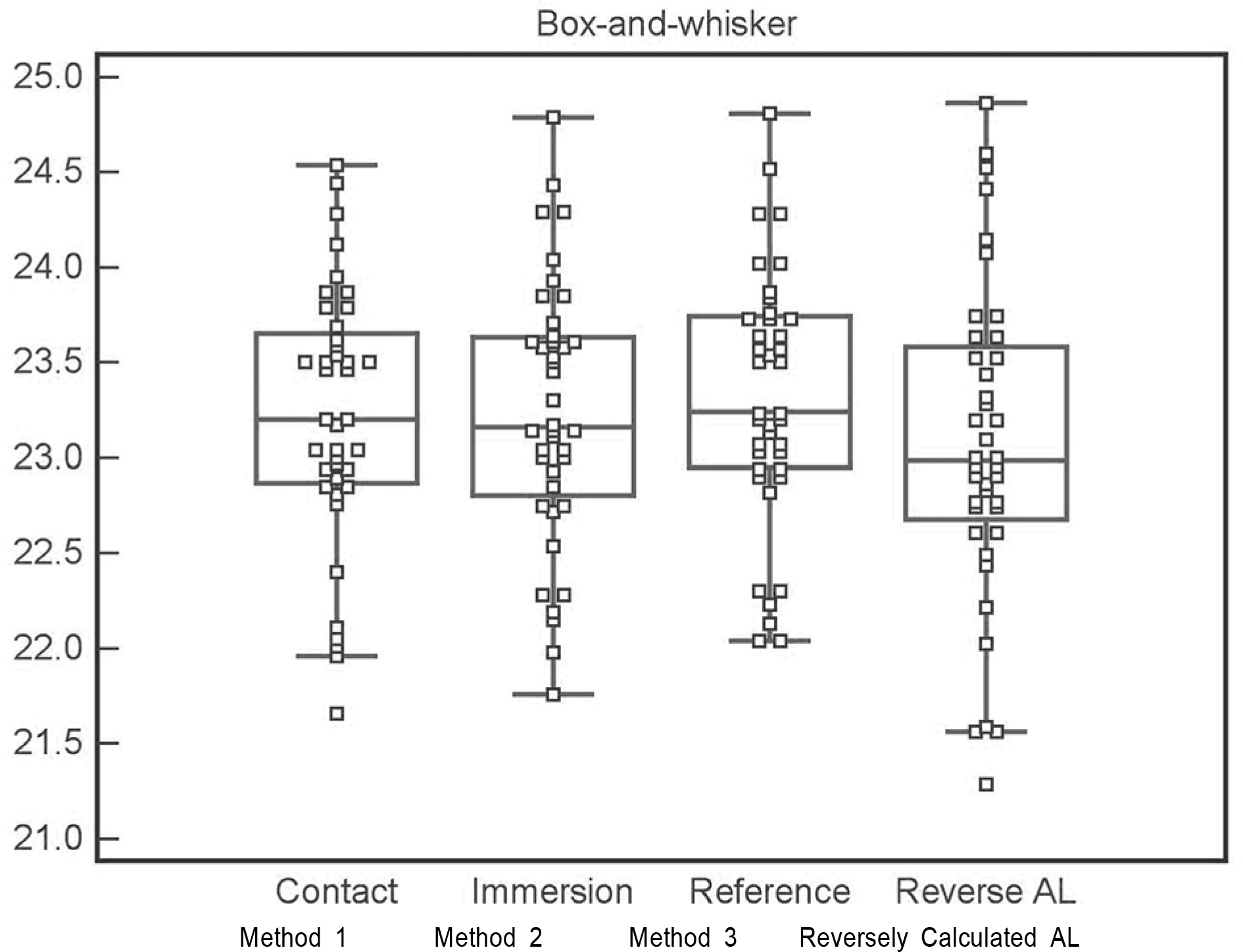J Korean Ophthalmol Soc.
2009 Dec;50(12):1795-1799. 10.3341/jkos.2009.50.12.1795.
Comparative Analysis of Contact and Immersion Technique in Ultrasonographic Biometry
- Affiliations
-
- 1Department of Ophthalmology, College of Medicine, Korea University, Seoul, Korea. hyomkim@hanmail.net
- KMID: 2212990
- DOI: http://doi.org/10.3341/jkos.2009.50.12.1795
Abstract
- PURPOSE
To establish the accuracy of the newly released biometer Ocuscan RxP(R) (Alcon, USA) by comparison with the established Ultrasonic Biometer Model 820(R) (Allergan Humphrey, USA), and to compare the accuracy of contact and immersion biometries.
METHODS
This is a prospective study involving 27 patients (40 eyes) who were scheduled for cataract surgery and had axial lengths measured with an Ocuscan RxP(R) biometer using both contact (Method 1) and immersion (Method 2) techniques. As a reference, a contact type Ultrasonic biometer 820(R) (Method 3) was also used. IOL(Intraocular Lens) power for the cataract surgery was calculated using this result. An axial length which would have caused no post-operative refractive error was reversely calculated from the difference of target diopter and post-operative refractive error. This length was compared with the axial lengths obtained via Methods 1, 2 and 3.
RESULTS
The means and standard deviations for the measurement sets were compared. Methods 1 and 2 showed no significant difference (23.22+/-0.68, 23.24+/-0.69 mm, p=0.55). The axial length measured by Method 3 was 23.32+/-0.67 mm. The difference between the target refraction and post-operative refractive error was 0.29+/-0.60D. The axial length was reversely calculated from the difference (23.07+/-0.84 mm). The differences between the reversely calculated axial lengths and those of Methods 1, 2 and 3 were 0.15+/-0.31, 0.17+/-0.31 and 0.24+/-0.28 mm, respectively.
CONCLUSIONS
Biometric results from Methods 1 and 2 caused less refractive error than did Method 3. The contact and immersion methods are both accurate for IOL power calculation if performed by a well-skilled examiner.
Keyword
MeSH Terms
Figure
Cited by 2 articles
-
Refractive Eerror According to the Anterior Chamber Depth and Corneal Refractive Power in Short Eyes
Jeong Ah Shin, Kyu Yeon Hwang, Man Soo Kim
J Korean Ophthalmol Soc. 2013;54(1):65-71. doi: 10.3341/jkos.2013.54.1.65.Comparison of Ocular Biometry Measured Using Four Applanation Ultrasonographic Biometry Devices
Byung Su Lim, Sang Kyu Lee, Eun Chul Kim
J Korean Ophthalmol Soc. 2014;55(11):1631-1635. doi: 10.3341/jkos.2014.55.11.1631.
Reference
-
References
1. Olsen T. Sources of error in intraocular lens power calculation. J Cataract Refract Surg. 1992; 18:125–9.
Article2. Olsen T. Theoretical approach to intraocular lens calculation using Gaussian optics. J Cataract Refract Surg. 1987; 13:141–5.
Article3. Leaming DV. Practice styles and preferences of ASCRS members-1999 survey. J Cataract Refract Surg. 2000; 26:913–21.
Article4. Binkhorst RD. The accuracy of ultrasonic measurement of the axial length of the eye. Ophthalmic Surg. 1981; 12:363–5.
Article5. Olsen T. The accuracy of ultrasonic determination of axial length in pseudophakic eyes. Acta Ophthalmol. 1989; 67:141–4.
Article6. Olsen T, Nielsen PJ. Immersion versus contact technique in the measurement of axial length by ultrasound. Acta Ophthalmol. 1989; 67:101–2.
Article7. Hitzenberger CK, Drexler W, Dolezal C. Measurement of the axial length of cataract eyes by laser Doppler interferometry. Invest Ophthalmol Vis Sci. 1993; 34:1886–93.8. Findl O, Drexler W, Menapace R, et al. Improved prediction of intraocular lens power using partial coherence interferometry. J Cataract Refract Surg. 2001; 27:861–7.
Article9. Giers U, Epple C. Comparison of A-scan device accuracy. J Cataract Refract Surg. 1990; 16:235–42.
Article10. Binkhorst RD. The accuracy of ultrasonic measurement of the axial length of the eye. Ophthalmic Surg. 1981; 12:363–5.
Article11. Hennessy MP, Franzco , Chan DG. Contact versus immersion biometry of axial length before cataract surgery. J Cataract Refract Surg. 2003; 29:2195–8.
Article12. Retzlaff JA, Sanders DR, Kraff MC. Development of the SRK /T intraocular lens implant power calculation formula. J Cataract Refract Surg. 1990; 16:333–40.13. Hoffer KJ. The Hoffer Q Formula: a comparison of theoretic and regression formulas. J Cataract Refract Surg. 1993; 19:700–12.
Article14. Holladay JT. Standardizing constants for ultrasonic biometry, keratometry, and intraocular lens power calculations. J Cataract Refract Surg. 1997; 23:1356–70.
Article15. Hwang JS, Lee JH. Comparison of the IOL master(R) and A-scan ultrasound: refractive results of 96 consecutive cases. J Korean Ophthalmol Soc. 2007; 48:27–32.16. Song BY, Yang KJ, Yoon KC. Accuracy of partial coherence interferometry in intraocular lens power calculation. J Korean Ophthalmol Soc. 2005; 46:775–80.17. Chung JK, Choe CM, You YS, Lee SJ. Biometry with partial coherence interferometry and ultrasonography in high myopes. J Korean Ophthalmol Soc. 2006; 47:355–61.18. Cho YA, Lee RH, Kim KS. The axial length of normal emmetropic eyes by ultrasonic biometry. J Korean Ophthalmol Soc. 1983; 24:27–33.19. Kim WJ, Park SH, Shin HH. The change of axial length according to age in the eyeball of premature infants by ultrasonic biometry. J Korean Ophthalmol Soc. 1983; 34:667–71.
- Full Text Links
- Actions
-
Cited
- CITED
-
- Close
- Share
- Similar articles
-
- Ultrasonographic measurement of optic nerve sheath diameter in normal dogs
- Comparison of Ocular Biometry Measured Using Four Applanation Ultrasonographic Biometry Devices
- Comparison of Intraocular Lens Calculation Formulas Measured by Immersion-Type A-Scan Ultrasound and Partial Coherence Interferometry
- Immersion radiography for enhancement of soft tissue contrast
- The Clinical Efficacy of the Haigis Formula Using A-Scan Contact Ultrasound Biometry




